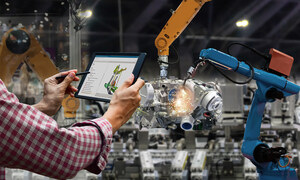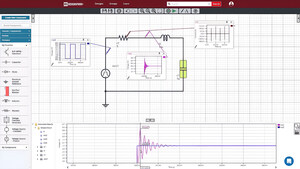PUES adopts Siemens' Capital electrical design software to streamline next-generation EV system design
-- PUES to utilize Siemens' digital innovation platform to integrate advanced technologies into electric vehicle design
-- Capital to provide a unified platform for faster and simpler design automation management
PLANO, Texas, April 16, 2019 /PRNewswire/ -- Siemens today announced that leading Japanese electric vehicle (EV) systems provider PUES Corporation has selected Capital™ electrical design software from Mentor, a Siemens business, to help speed and simplify the development of next-generation automotive electrical/electronic (E/E) systems. PUES is an EV systems pioneer with a 30-year track record of helping the world's leading car manufacturers and their suppliers integrate advanced technologies into their products.
PUES turned to Siemens' Capital software after years of using discrete point solutions across multiple engineering domains. These legacy tools were ultimately overwhelmed by increasingly complex E/E challenges resulting from automated driving requirements, stringent global emissions regulations and unyielding market pressure to reduce costs and speed time-to-market. With the limited compatibility of the legacy tools and the challenges of coherent data exchange through the E/E flow, making design changes in one domain required time-consuming and error prone rework in other domains, executed using diverse design environments.
The latest in a series of industry-leading products from Mentor to join Siemens' expanding software portfolio, the Capital suite provides PUES with a unified platform delivering design automation and design change management across multiple E/E domains. PUES uses Capital for a wide array of tasks including E/E system architecture definition, electrical system and wire harness design, configuration and change management, as well as functional verification and manufacturing process generation.
"At PUES, we've being working closely with our customers to rapidly develop EV/HEV system prototypes and to fulfill other related development requests. Capital is a true electrical collaboration platform that provides the digital continuity we need across a broad range of critical tasks to get EV electrical systems to customers faster," said Kishi Shingo, executive officer for PUES. "Because many of the world's leading automotive OEMs and suppliers also use Capital, as well as adjacent Siemens products such as embedded software for AUTOSAR-based systems, we expect to realize even more efficiency moving forward, due to streamlined collaboration with our global customer base."
Because the Capital software automates the production of documentation linking assets such as wiring schematics, component locations, harness views and diagnostic procedures, PUES can add value and boost customer satisfaction, even as autonomous drive functionality and other fast-evolving requirements dramatically increase the complexity of EV systems.
"PUES is a longtime leader in EV systems, and its relevance continues to grow as electrified powertrains become increasingly central to automotive innovation," said Doug Burcicki, automotive market director for Siemens' Capital Software portfolio. "Using Capital software can help PUES achieve new levels of efficiency as it continues to deliver world-class EV system technologies for its large and growing base of customers."
Developed particularly for transportation applications, Siemens' Capital software spans an extended flow from concept and electrical architecture definition to wire harness design, manufacture and vehicle maintenance. Combining powerful design automation and modern enterprise integration capabilities, the software creates digital continuity within the electrical domain to help compress development cycle time and deliver a significant cost reduction. Capital tools can be implemented individually or deployed together in a unified flow that seamlessly matures data within a consistent environment. Robust integration with adjacent domains (such as requirements management, mechanical CAD and PLM) is fully supported, as is cross-organizational collaboration.
Siemens Digital Industries Software is a leading global provider of software solutions to drive the digital transformation of industry, creating new opportunities for manufacturers to realize innovation. With headquarters in Plano, Texas, and over 140,000 customers worldwide, Siemens Digital Industries Software works with companies of all sizes to transform the way ideas come to life, the way products are realized, and the way products and assets in operation are used and understood. For more information on Siemens Digital Industries Software products and services, visit www.siemens.com/plm.
Follow us on Twitter at: www.twitter.com/siemensplm
Siemens Digital Industries (DI) is an innovation leader in automation and digitalization. Closely collaborating with partners and customers, DI drives the digital transformation in the process and discrete industries. With its Digital Enterprise portfolio, DI provides companies of all sizes with an end-to-end set of products, solutions and services to integrate and digitalize the entire value chain. Optimized for the specific needs of each industry, DI's unique portfolio supports customers to achieve greater productivity and flexibility. DI is constantly adding innovations to its portfolio to integrate cutting-edge future technologies. Siemens Digital Industries has its global headquarters in Nuremberg, Germany, and has around 75,000 employees internationally.
Siemens AG (Berlin and Munich) is a global technology powerhouse that has stood for engineering excellence, innovation, quality, reliability and internationality for more than 170 years. The company is active around the globe, focusing on the areas of electrification, automation and digitalization. One of the largest producers of energy-efficient, resource-saving technologies, Siemens is a leading supplier of efficient power generation and power transmission solutions and a pioneer in infrastructure solutions as well as automation, drive and software solutions for industry. With its publicly listed subsidiary Siemens Healthineers AG, the company is also a leading provider of medical imaging equipment – such as computed tomography and magnetic resonance imaging systems – and a leader in laboratory diagnostics as well as clinical IT. In fiscal 2018, which ended on September 30, 2018, Siemens generated revenue of €83.0 billion and net income of €6.1 billion. At the end of September 2018, the company had around 379,000 employees worldwide. Further information is available on the Internet at www.siemens.com.
Note: A list of relevant Siemens trademarks can be found here. Other trademarks belong to their respective owners.
SOURCE Siemens Digital Industries Software
Related Links
WANT YOUR COMPANY'S NEWS FEATURED ON PRNEWSWIRE.COM?
Newsrooms &
Influencers
Digital Media
Outlets
Journalists
Opted In





Share this article